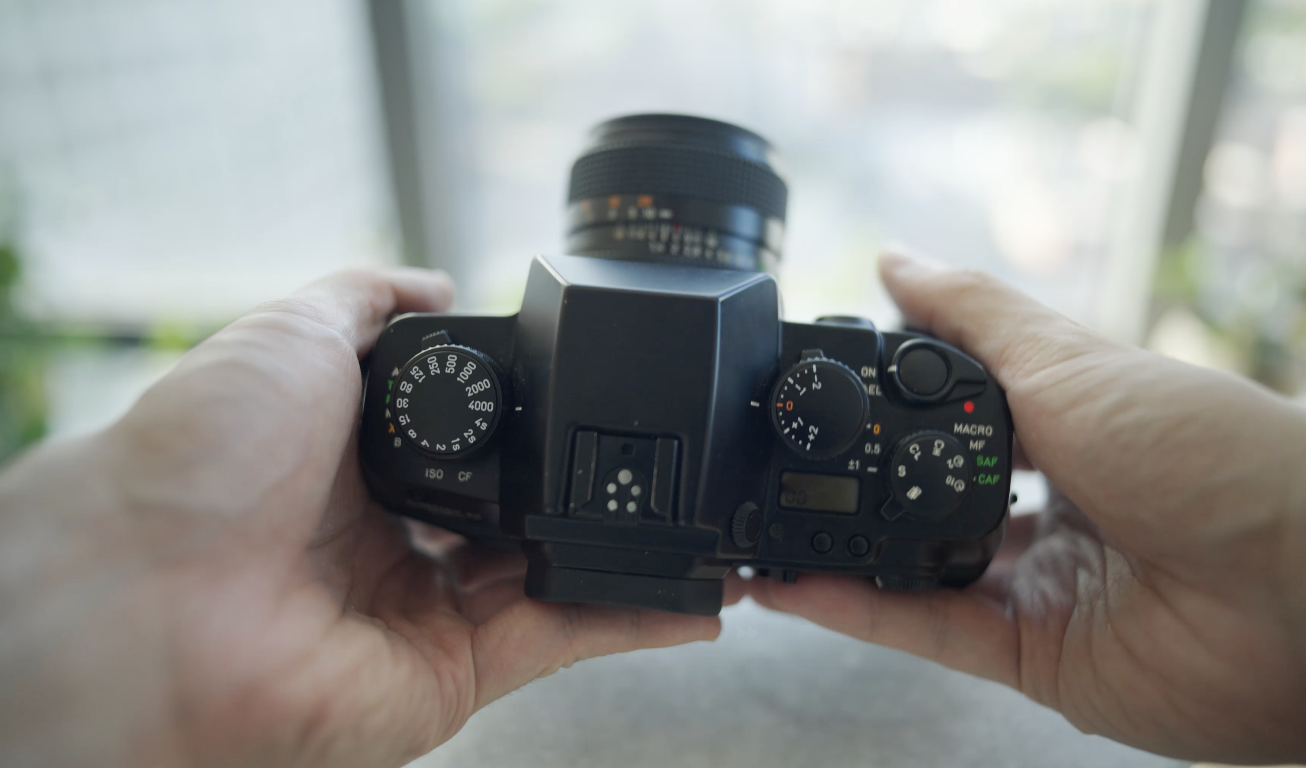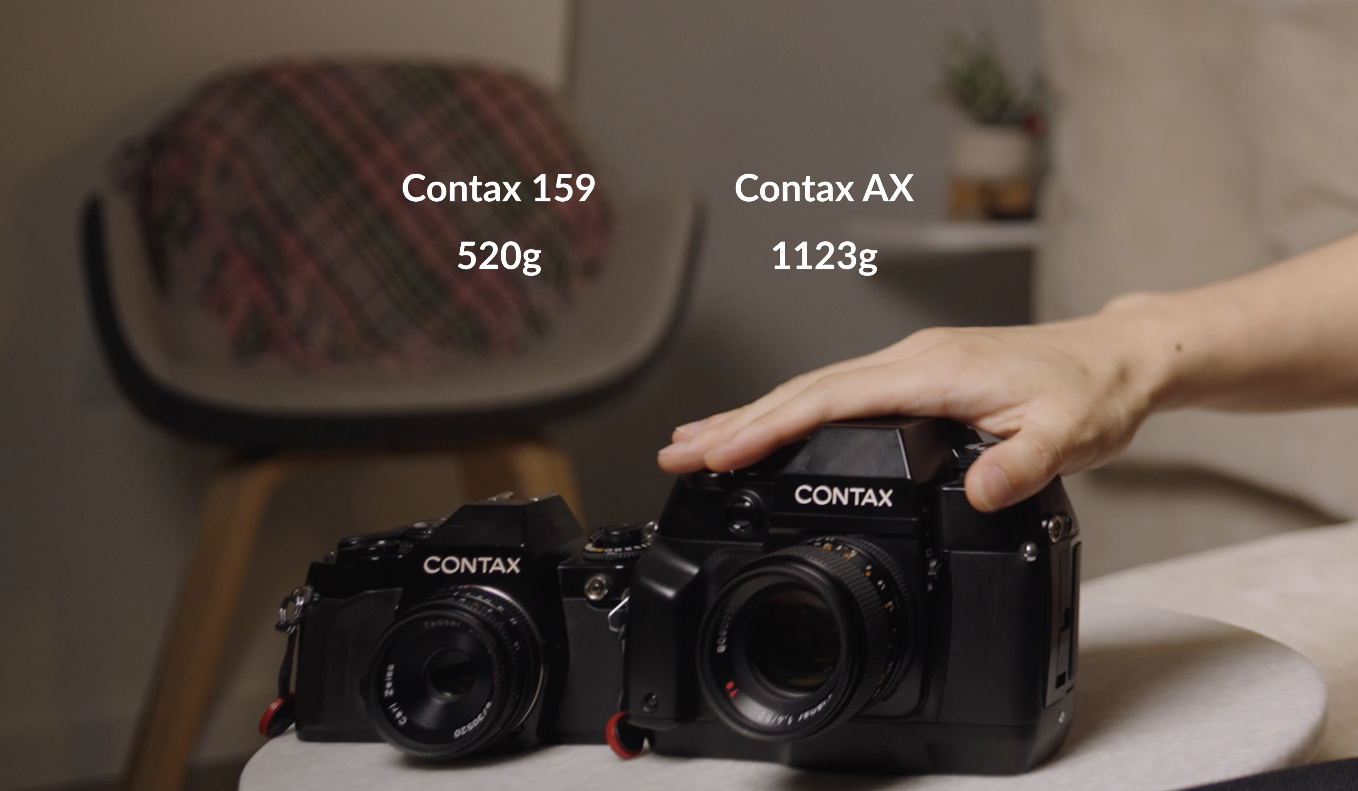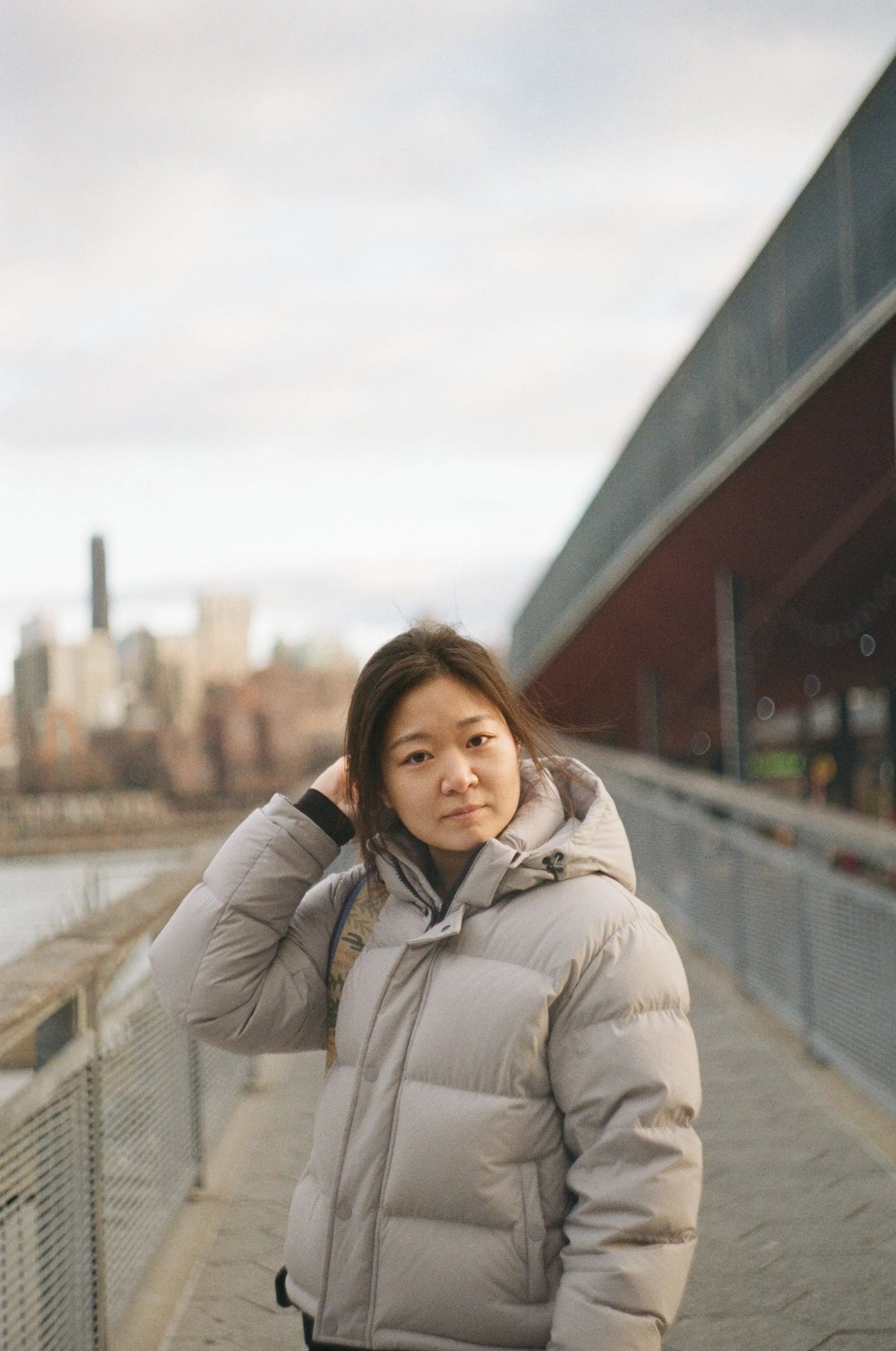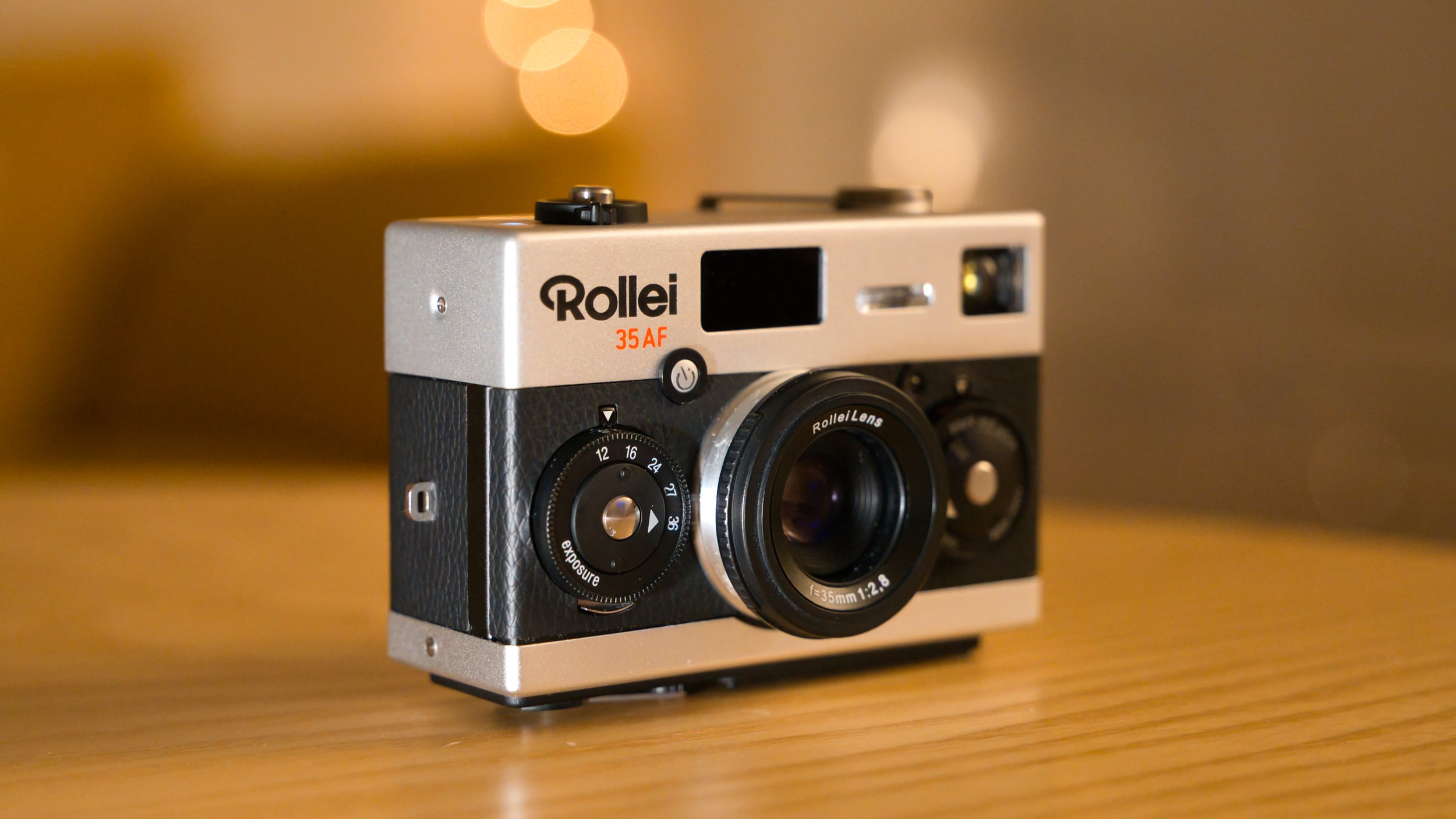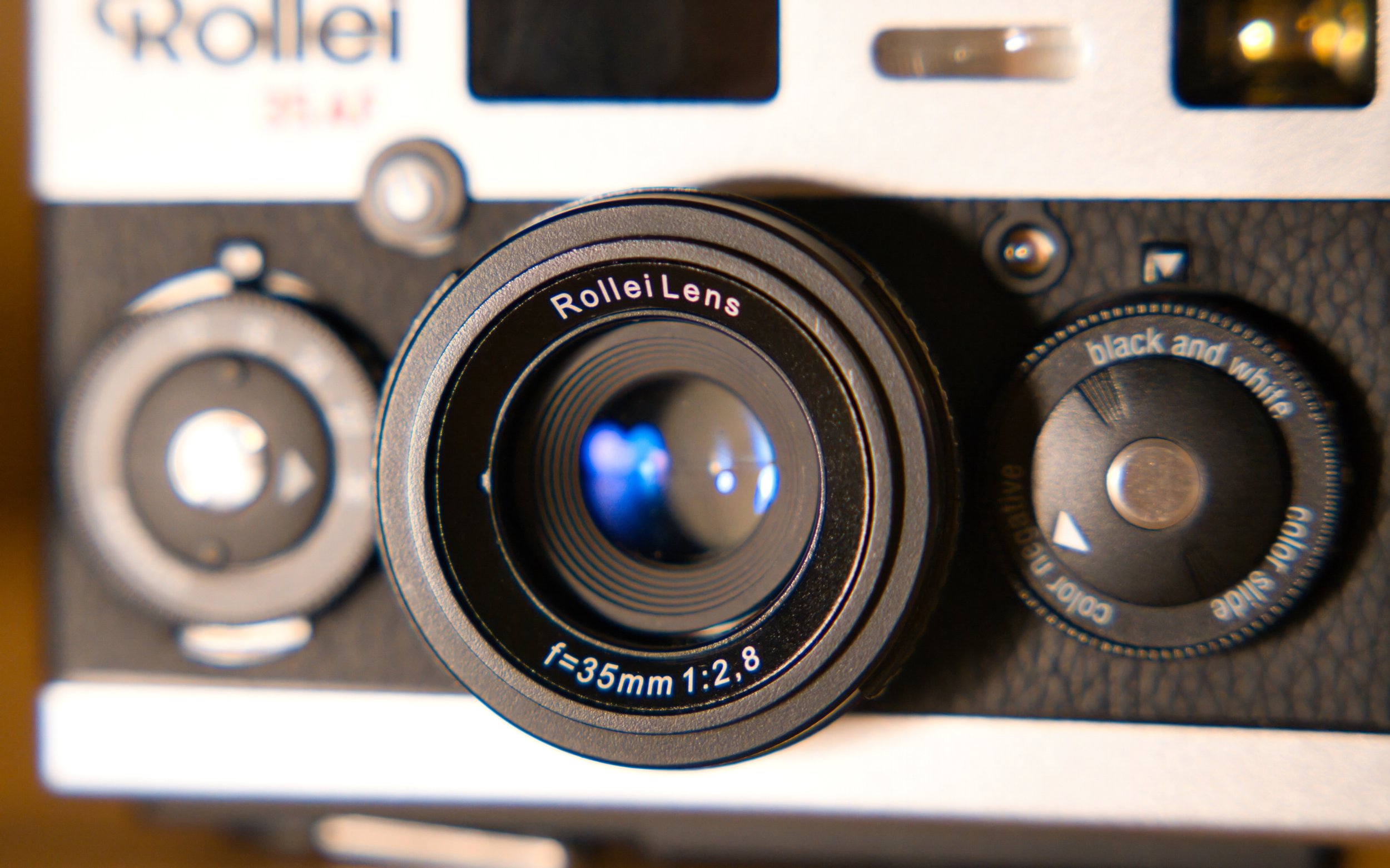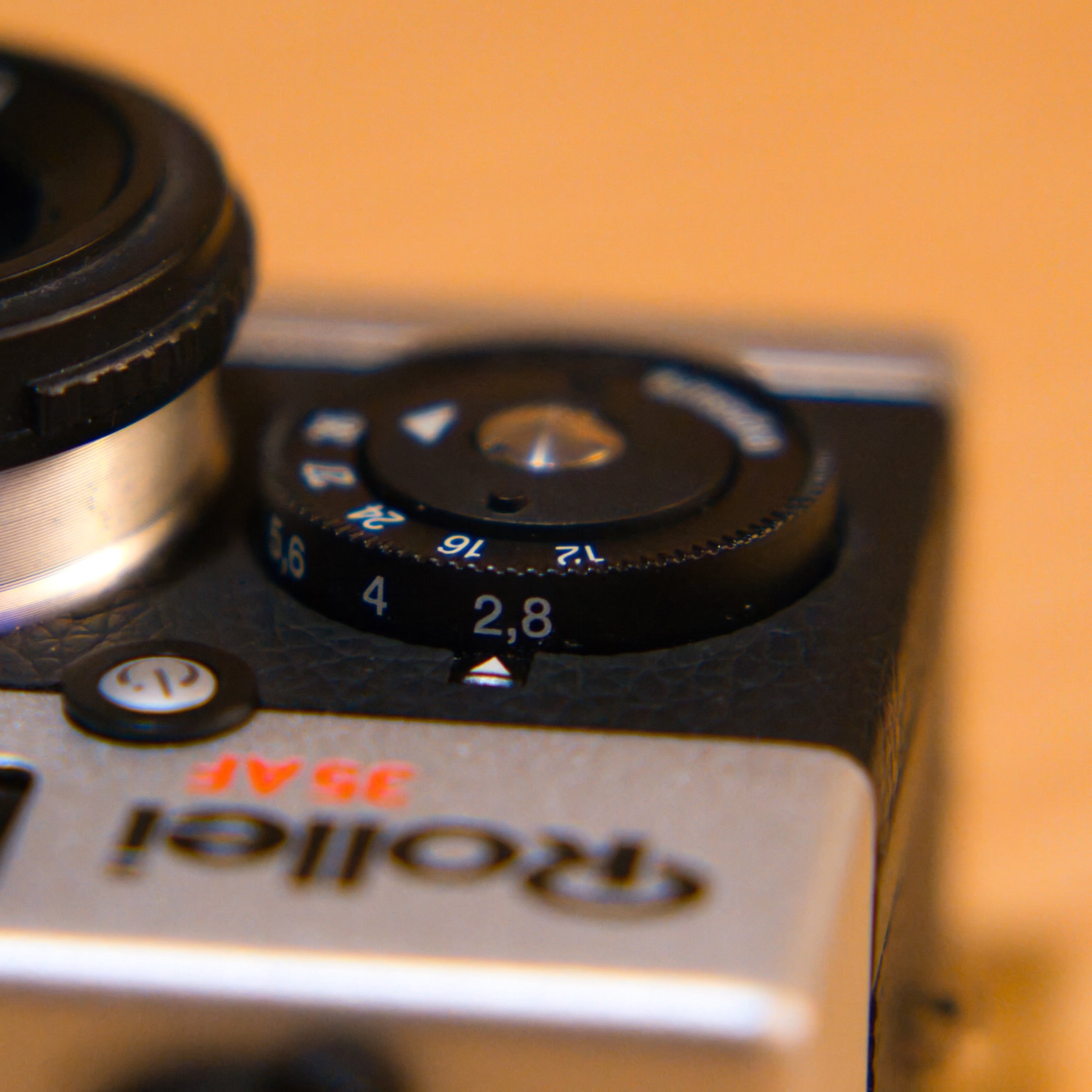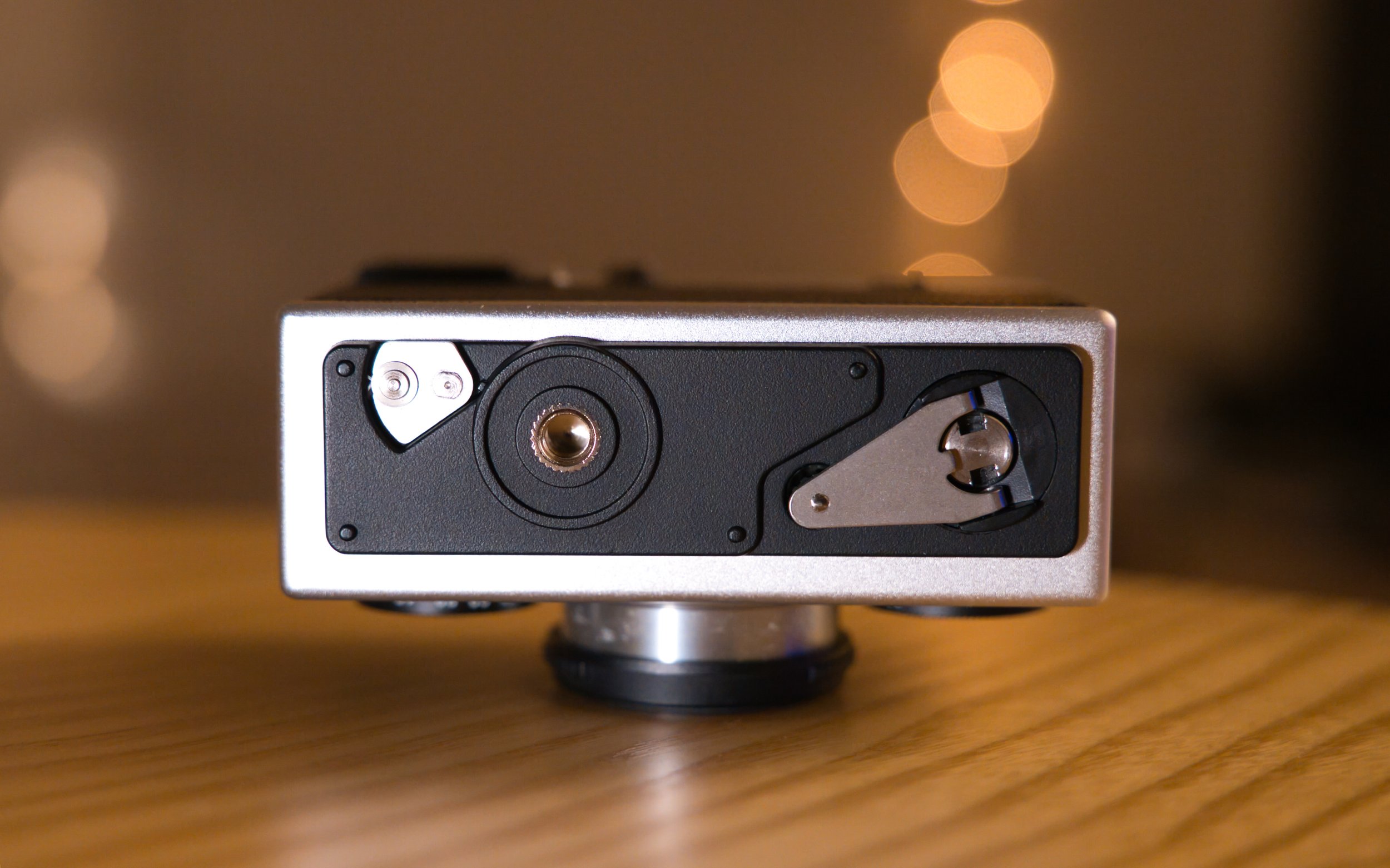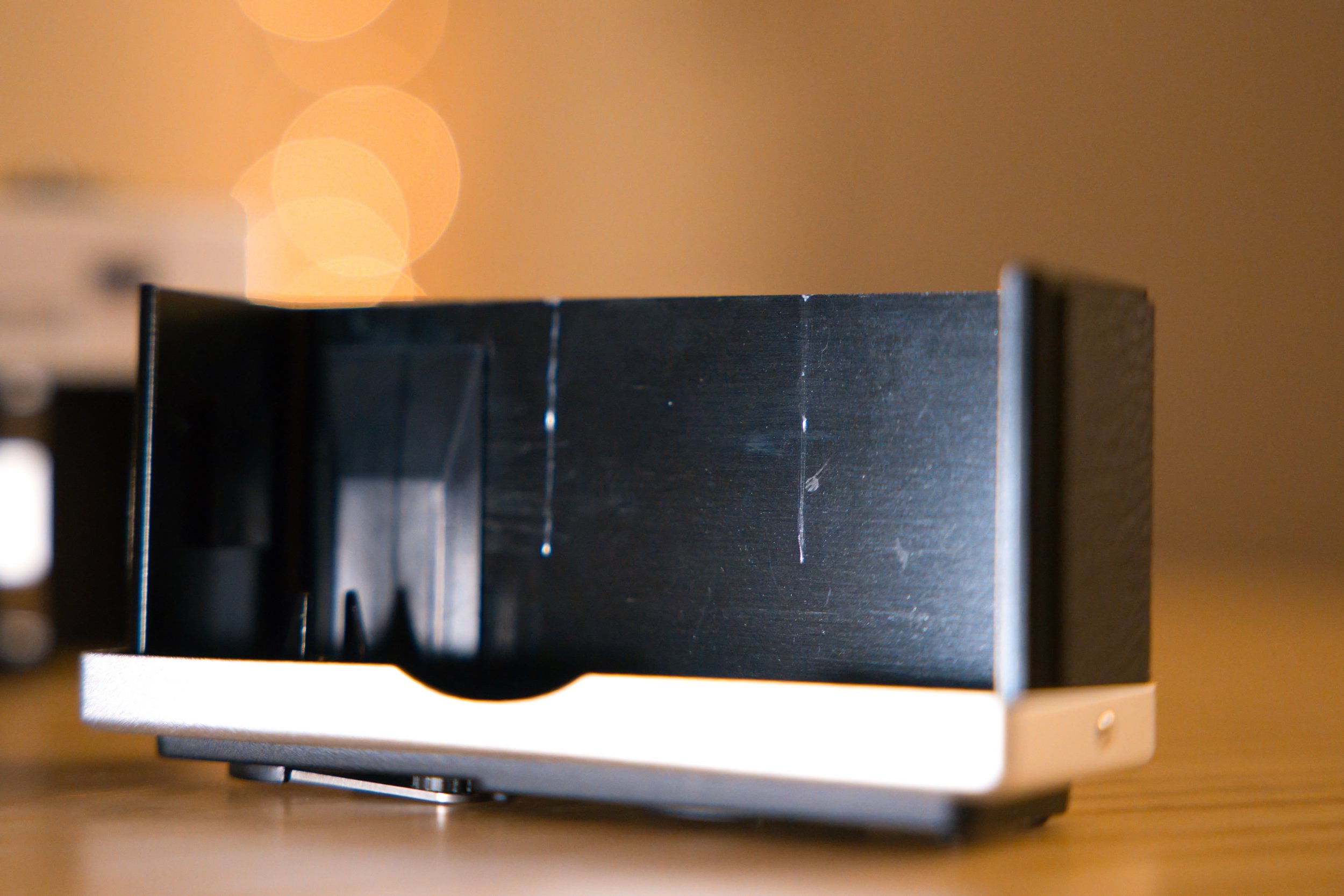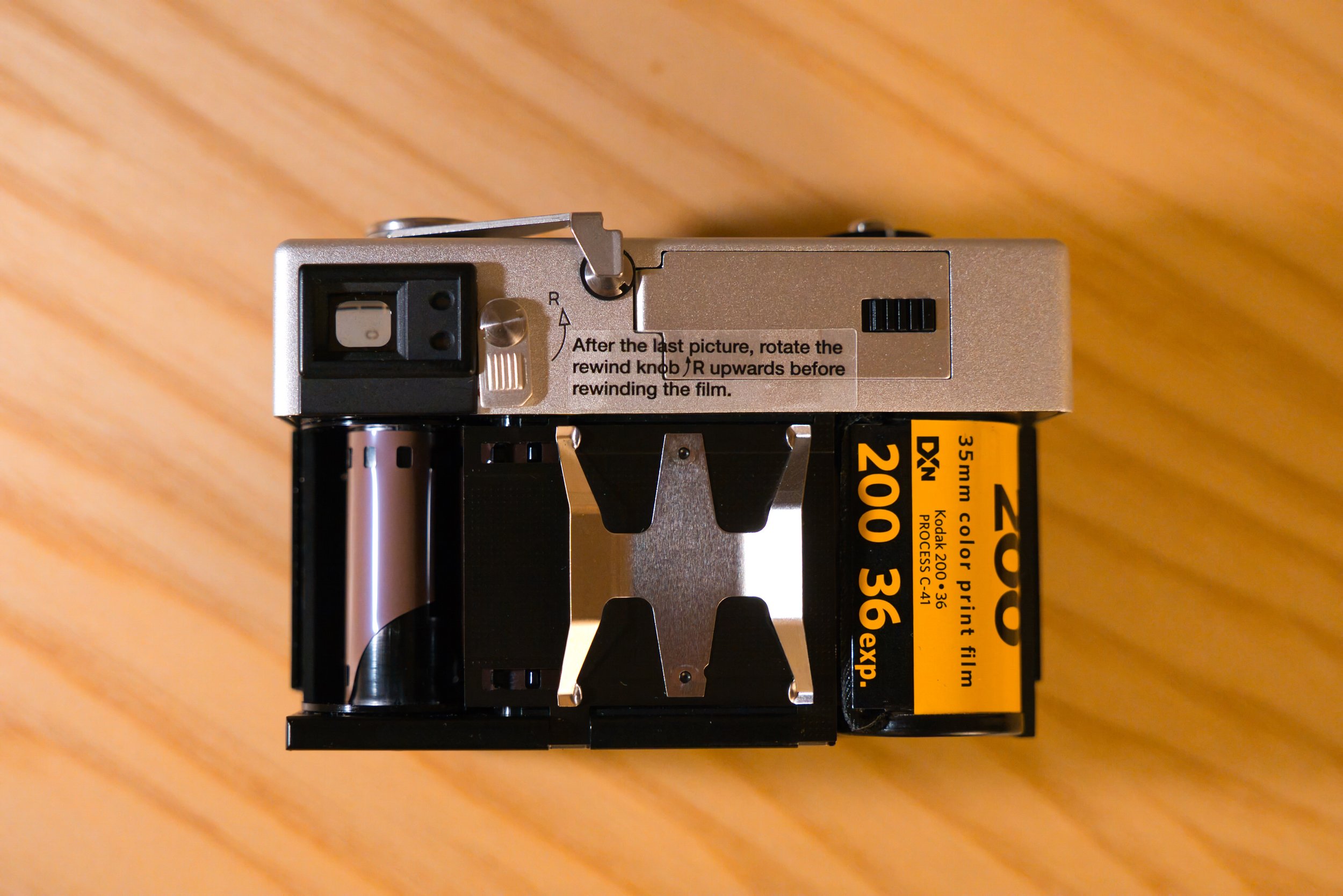Review: Contax AX
Background
By the mid-1990s, autofocusing tech was in full swing. Canon, Nikon, and Minolta had been integrating it into their 35mm cameras since the early '80s, and by now, pretty much every brand was chasing faster, smarter lenses that could focus themselves.
Autofocus works by using an electronic motor to shift specific internal glass elements, adjusting the plane of focus. Simple in theory, but it changes everything about how a lens is designed and built.
This posed a real problem for Contax. How do you move forward with autofocus without abandoning the lineup of beautifully built, manual-focus Zeiss lenses people already loved?
To zoom out for a second: Zeiss, the German optics giant, had sold the Contax brand to Kyocera, a Japanese company looking to modernize the system. Kyocera wanted full-blown autofocus, but Zeiss wasn’t ready to ditch their Contax/Yashica-mount lenses, or the loyal user base that came with them. They feared the potential backlash if they suddenly made all that legacy glass obsolete.
So what did they do? They devised a workaround that was so wild and beautifully overengineered that it became one of the most fascinating film cameras ever made.
Instead of putting autofocus functionality in the lenses, they added it to the camera body.
Released in 1996, the Contax AX remains the only film camera ever made that can autofocus manual lenses. While most manufacturers introduced entirely new autofocus lens systems, Contax chose to keep their existing Zeiss lens lineup compatible by building the autofocus mechanism into the camera body.
The AX achieves this by physically moving the entire film plane and mirror box assembly back and forth to shift the plane of focus, leaving the lens itself completely untouched. This clever workaround allows full autofocus functionality without changing the optical design of the lenses. Contax dubbed this technology the Automatic Back Focusing System.
The result is a camera body that’s noticeably large, closer in size to a medium format system than a typical 35mm SLR.
Specs
Camera: Contax AX
Release Date: April 1996
Type: 35mm Film SLR
Mount: Contax/Yashica (C/Y)
Focus: Automatic Back Focusing
System: Electronic
Shutter Speeds: 4s - 1/4000s Manual + AV & P Modes: 4s - 1/6000s + Bulb
Motor Drive: Automatic Film Advance
Metering: Center-weighted Average + Spot Metering
Film Speeds: DX Code: ISO 25 - 5000; Manual ISO: 6 - 6400
Exposure Modes:
(AV) Aperture Priority
(TV) Shutter Priority
(P) Auto
(M) Manual
(X) Flash
(B) Bulb
Weight: 1123g (With Battery)
Power: (1) 2CR5 Battery
Weather Sealing: None
Price: $200 - $300 USD Used (Initially released at $2795 USD in 1996, $5730 today)
Body
By the 1990s, the Contax SLR system was firmly established. Earlier cameras like the Contax RTS, 137 MD, 159MM, and the Yashica FX-3 had earned a solid reputation for being both reliable and well-designed. The Contax/Yashica lineup stood out as a thoughtful collaboration between German and Japanese engineering: Yashica (and later Kyocera) handled the electronics, Zeiss supplied the optics and overall engineering, and the camera designs themselves were styled by Porsche. It was a rare blend of technical performance and beautiful aesthetics.
While the initial Contax cameras of the 1980s were minimal and sleek, the cameras in the latter years of the Contax SLR system were becoming larger and larger, with added technology such as an integrated motor drive for automatic film advancing.
The Contax AX looks like an absolute behemoth compared to its predecessors.
There’s a lot to cover in terms of the functions and capabilities of the Contax AX’s camera body.
Let’s start with the top plate…
Starting on the left side of the top plate, you’ll notice the shutter speed dial, unlike most 35mm SLRs, where it’s typically on the right, Contax places it on the left. The AX offers a full range of shutter speeds from Bulb, 4 seconds, all the way up to 1/4000s. In Aperture Priority or full Program modes, it even extends to 1/6000s.
Just to the left of the shutter dial is a mode selector. You’ll need to press a small button below the “ISO” label to unlock and rotate this switch. The available modes are:
AV – Aperture Priority
TV – Shutter Priority
P – Program/Auto
M – Manual
X – Flash Sync
B – Bulb
Continue turning the switch past the shooting modes, and you’ll land on ISO. Here you can set your ISO manually, from 6 to 6400. The AX also includes a DX code reader to automatically detect ISO from most standard film canisters, but if you're using bulk-rolled film or non-coded third-party stocks, manual ISO control is easy to access.
In addition to the ISO setting, there’s also a “CF” option on the dial—short for Custom Functions. I’ll go into more detail about those further down, but for now, let’s move over to the right side of the top plate, where most of the camera’s controls live.
Exposure Mode Dials
ISO & Custom Function
At the top right corner, you’ll find the main power switch, which also includes an AEL (Auto Exposure Lock) function to lock your exposure. Left to that is the Exposure Compensation dial, allowing for adjustments in ±2-stop increments. Attached to it is a small lever called ABC (Auto Bracketing Control), which lets you shoot three frames in a row with either ±0.5 or ±1-stop exposure differences. This is especially useful for landscape work or situations where you want to make sure you nail exposure, something common in modern digital bodies, but relatively advanced for film cameras in the '90s.
Below the Exposure Compensation dial on the right is the shutter speed and drive mode dial. Pulling up on the dial lets you switch between different shooting modes: Double Exposure, Single Shot, Continuous Low (3 fps), Continuous High (5 fps), 2-second self-timer, and 10-second self-timer. While it’s not quite as fast as a Nikon F5, the 5 fps option is still capable for sports or action.
A small switch for adjusting the focus mode is built into the same dial. Your options are CAF (Continuous Autofocus), SAF (Single Autofocus), MF (Manual Focus), and a unique Macro mode. This Macro mode takes advantage of the AX’s internal focusing mechanism, which physically shifts the film plane forward, essentially acting like a built-in extension tube. You lose autofocus in this mode, but thanks to the bright, clear viewfinder, manual focus is still very usable for close-up photography.
Lastly, on the lower left side of the top plate, there’s a small digital display showing your frame count, ISO, and a few other basic readouts.
Now, back to the Custom Function (CF) setting mentioned earlier. This lets you tweak deeper settings, though it’s not the most intuitive system. When you enter CF mode, the camera displays a pair of numbers: one from 1 to 8 (representing the function), and one from 0 to 1 (to toggle that function on or off). Here’s a breakdown of what those settings control:
| Function | 0 | 1 |
|---|---|---|
| 1. Exposure Check Buttom | Display Exposure | Auto Exposure Lock (AV, TV, P Mode) |
| 2. Multiple Exposure | 2-9 Number of Exposures | Set multiple exposures according to drive dial |
| 3. Shooting order of ABC | Standard -> Over -> Under | Over -> Standard -> Under |
| 4. Stop-Down Buttom | Stopped down when button is pressed | Stopped down when button is pressed and aperture fully opens when pressed a second time |
| 5. Film Leader | Film is completely rewound back into the cassettte | Film leader remains outside the cassette after rewind |
| 6. Rewind | Rewinding with the rewind lever | Automatic rewind when film is finished |
| 7. AF Assist Lamp | AF Assist Lamp On | Off |
| 8. AF Sound | AF Beep when focus aquired | Off |
As you can see, the Custom Function settings offer a fair amount of flexibility. Personally, I only make a few adjustments: I disable auto film rewind (6-0), turn off the AF assist lamp (7-1), and mute the autofocus confirmation beep (8-1). I appreciate that Contax gave users the option to toggle these features off. The viewfinder provides clear focus confirmation, so there’s really no need for an audible beep or a glowing assist light, both of which can be distracting, especially when shooting in quiet or low-light environments.
The rear of the Contax AX is much simpler than the top plate, with fewer buttons but all the essentials in the right places. On the left side, you’ll find the button used to adjust the left dial—this needs to be held down when switching between exposure modes.
At the center is the viewfinder, which is easily one of the best I’ve used on an SLR. It’s bright, clear, and includes a built-in diopter adjustment. Just to the left of the eyepiece is a viewfinder blind switch, useful for preventing light leaks during long exposures.
To the right of the viewfinder is the film rewind lever. You’ll need to press a small button first before toggling the lever. This is something I really appreciate, since it prevents accidental rewinds mid-roll.
Further to the right is the autofocus control button. It’s paired with a surrounding dial that lets you choose between standard autofocus or AF lock, which is helpful when you want to recompose your shot without shifting focus.
Looking through the viewfinder, you’ll see an LED information bar along the bottom that displays everything you need while shooting.
On the far left is the frame counter showing your current position on the roll. Next to it is the metering mode indicator. In the center is the Automatic Back Focusing scale, which shows how much the internal mirror box is shifting to achieve focus. On the far right, you’ll see your exposure readout indicating aperture and shutter speed values, so you can quickly confirm your settings without taking your eye away.
Automatic Film Loader
The left side of the camera gives you access to the film compartment. When you open the back, you’ll see the Automatic Back Focusing system reset, and the mirror box slides back to its default position to make room for loading.
Loading film is straightforward. Just drop in the film cassette, pull the leader across to the green marker, and close the back. The camera takes care of the rest, automatically advancing the film to the first frame.
The bottom plate of the camera is easily removable using a simple plastic locking tab. Unlike the rest of the camera’s solid, metal construction, the plate itself is made from thin plastic and feels noticeably more delicate. It also covers the battery compartment, so it’s worth being careful not to misplace it.
Not sure if this is present on every Contax AX, but my version also has a plastic film with the table displaying all the Custom Function information.
The front of the camera is fairly minimal. There’s a modest grip, a prominent AF assist lamp, and a few essential controls: an exposure check button, a lens release button, and an aperture stop-down button. Everything is cleanly laid out and easy to access without cluttering the design.
Just opposite the lens mount is a small but important metering lever. It lets you switch between Center-Weighted Average and Spot Metering. It’s easy to overlook, so it’s worth checking regularly to make sure you’re metering the way you intend.
All things considered, there’s a lot happening on the Contax AX body, but after spending time with it, everything becomes second nature. If you’re used to working with button-heavy systems like cinema cameras or modern pro mirrorless bodies, you’ll probably find the layout pretty intuitive.
Custom Function Table
Exposure Metering Mode Lever
The biggest challenge with the AX is its sheer weight and somewhat awkward ergonomics. It’s not the most uncomfortable camera I’ve used, but the sharp edges and bulk make it tough to handhold for extended periods. A solid camera strap is a must if you plan to carry it around for a full day.
For context, it weighs about the same as a medium format Mamiya 7.
Let’s move onto the lens options for the Contax AX…
Lenses
Click to expand images.
One of the biggest reasons to invest in the Contax AX and the Contax/Yashica SLR system is the incredible lineup of Zeiss and Yashica lenses available.
The Contax Zeiss glass, in particular, ranks among the best SLR lenses ever made. These lenses remain popular today, whether photographers adapt them to modern mirrorless cameras or videographers seek lenses with unique character. The Zeiss Planar 50mm f/1.4, for example, is a favorite for adapting to digital bodies. These lenses share heritage with the legendary Zeiss Super Speed cinema lenses used on iconic films like The Shining, The Terminator, Full Metal Jacket, and Lost in Translation.
Here’s a full database of Contax/Yashica lenses for reference.
You’ll notice some lenses are marked AE (Auto Exposure) or MM (Multi Mode), usually you’ll see them followed by a third letter indicating manufacturer origin, (J) Japan or (G) Germany. AE lenses were the original Zeiss offerings for the system. They don’t have a mechanical link to the camera body and are known for a distinctive “Ninja Star” bokeh, caused by aperture blades that don’t form a perfect circle, creating unique out-of-focus highlights.
MM lenses came later and include a mechanical connection that enables shutter priority and program auto-exposure modes. These lenses don’t have the Ninja Star bokeh, making them more popular with videographers. You can spot MM lenses by their green aperture markings. On the Contax AX, you’ll also see the shutter priority (TV) and program (P) modes marked in green, reminding you that MM lenses are required to use these modes.
While many say there’s no optical difference between AE and MM lenses, I’ve noticed the coatings and glue used in MM lenses are different, affecting their durability and image quality.
A couple of popular MM lenses, like the Contax 50mm f/1.4 Planar and the Contax 100-400mm zoom, are known to have lens fogging issues. If you come across a fogged lens on eBay, I recommend reaching out to a Taiwanese lens repair specialist I trust. He’s repaired two of my Contax lenses without any problems.
You can find him here: https://lens-cla.blogspot.com/ or contact him by email at lin0975165383@gmail.com.
Cinestill 800T. The Contax AX’s metering modes favors the center of the image.
Another great feature of the Contax AX is its ability to use a wide range of lenses beyond just the Contax Zeiss lineup. If you’re looking for a more budget-friendly option, the Yashica ML lenses are worth considering. These were the higher-end lenses from Yashica and offer surprisingly good image quality, often approaching that of the Contax Zeiss lenses. That said, they’re not built to the same standard. The ML lenses rely more on plastic and glue in their construction, so while the optics hold up well, the build feels noticeably cheaper. On the plus side, they’re much lighter, which can be a welcome relief given how heavy the Contax AX is.
Just a heads-up: avoid the Yashica DSB lenses. These were the lower-tier versions and are known for poor optical performance. Stick with the ML versions if you're looking for quality at a lower price.
In addition to Yashica ML lenses, the Contax AX can also mount and autofocus M42 screw-mount lenses with the right adapter. This opens up access to a huge library of classic lenses, including well-known options like the Helios 44 series and Carl Zeiss Jena lenses.
I’ve personally adapted my Helios, Biotar, and Carl Zeiss Jena lenses to the AX, and being able to autofocus with these vintage lenses is a real bonus. It’s one of the few ways to give old manual-focus glass modern autofocus functionality, without losing the character that makes those lenses special! In my opinion, this is the most beautiful benefit of shooting with the Contax AX. You can keep all of your Contax Zeiss lenses and M42 lenses on one film camera.
Images
In order to autofocus with manual lenses on the Contax AX, you’ll need to first set the lens to infinity, then tap the AF button to let the camera do the work.
That said, autofocus on the AX is somewhat limited by today’s standards, with its one autofocus point. While it’s generally responsive, it doesn’t quite hold up to contemporaries like the Nikon F5 (released in 1996 with 5 autofocus points) or the Canon EOS 3 (1998, with 45 autofocus points and an innovative Eye-Control system that let you select focus points just by looking).
Still, the AX’s autofocus is perfectly usable if you’re comfortable working with a single focus point. In low-light or challenging situations, you can always let the AX get close by tapping the AF button, then fine-tune the focus manually. It’s a unique hybrid experience, but one that works surprisingly well once you get used to it.
Final Thoughts
Pros:
Unique Autofocus
Very customizable functions
3-5 FPS burst
Macro functionality
Ability to adapt C/Y and M42 lenses
Auto film advance and rewind
Aperture Priority, Shutter Priority, and Auto
Cons:
Incredibly heavy
New photographers may be overwhelmed with functionality
Custom Function system can be confusing
Over-engineered
At the end of the day, the Contax AX is the most over-engineered 35mm film camera I’ve ever used. It was designed as a bold solution to a problem Contax couldn’t fully avoid. Despite the AX’s attempt to preserve the legacy of manual Zeiss lenses, Kyocera eventually moved on to the Contax N system with dedicated autofocus lenses. Not long after, the Contax brand was shuttered in the early 2000s, and the name returned to Zeiss.
Another downside to owning a Contax AX, or really, most Contax SLRs, is their heavy reliance on electronics. If something goes wrong, repairs can be difficult, if not impossible. There are very few technicians who still work on these cameras, and parts are increasingly hard to come by.
My own Contax AX developed a mechanical issue with the lens mount ring, and I had to send it to Nippon Photo Clinic, the only certified Contax repair center in the U.S. Fortunately, they were able to fix it, but it’s a reminder that owning one of these cameras comes with some risk.
Rating: 4/5
While the AX is definitely a luxury 35mm film camera, its ability to autofocus with a wide range of manual lenses gives it a truly unique place in the market. It may not be as practical or battle-ready as something like the Nikon F5 or Canon 1V, but it’s still very usable and in my view, deserves recognition as one of the most unusual and ambitious film cameras ever made.
Review: Rollei 35 AF
Background
2024 was an exciting year for film photographers. While the past five years have witnessed a resurgence in film photography and the release of new film stocks, the market had yet to see the arrival of any serious new film cameras. That changed over the past 12 months with the introduction of two exciting models: the half-frame Pentax 17 and the much-anticipated autofocus Rollei 35 AF.
Cinestill 800T
Delta 3200
While the Pentax 17 generally received a warm welcome from the film community, the Rollei 35 AF had some mixed reactions from photographers. The Rollei 35 AF is produced by Hong-Kong based MiNT Camera, a company largely known for it’s production of modern instant film cameras with vintage designs. This is their first forray into a serious autofocus 35mm camera and their design for the new camera was inspired by the classic Rollei 35 zone-focus film cameras that were produced from 1966 - 1981. The original Rollei 35 cameras are somewhat cult-classics within the film community for their incredible compact size, zone-focusing system, and beautifully engineered German-optics. There was a high expectation for those who loves the classic Rollei 35.
Pro Image 100
Pro Image 100
To avoid confusion in this review, I’d like to clarify that MiNT Camera bought the rights to use the German “Rollei” brand and are not the original manufacturers of the classic Rollei 35. While the Rollei 35 AF shares visual resemblance in camera body structure as the vintage Rollei 35, that’s where the similarities end.
Specs
Camera: Rollei 35 AF
Release Date: September 2024
Type: 35mm Film Point-and-Shoot
Mount: Fixed Lens 35mm f/2.8
Focus: LIDAR Autofocus
System: Full-Electronic
Shutter Speeds: 60s - 1/500s; 10s Self-Timer
Motor Drive: Manual Film Advance
Metering: Center-weighted Average
Film Speeds: ISO 25 - 3200
Exposure Modes: Aperture Priority; Manual
Weight: 242g (Without Battery)
Power: (1) 2CR5 Battery
Weather Sealing: None
Price: $799.00 USD
Body
The Rollei is designed and built from the ground up by Gary Ho of MiNT Camera. He and MiNT spent about 5 years of Research and Development into this new camera design and spent most of 2024 with marketing the camera and teasing its eventual release. Gary and the MiNT team remained faithful to the original Rollei 35 aesthetic but the inner workings and photo-taking process is completely different from the classic German Rollei experience.
This tiny 35mm lens is constructed of 5 glass elements and has a f/2.8 max aperture. I believe this lens was designed by former Pentax engineers and the lens on this Rollei produces perfectly acceptable photos with a bit of character. The front of the lens is an odd design. It mimics the original Rollei 35 but lacks any filter threads to use any colored filters for black and white photography. The lens cap is also constantly falling off and will slowly lose even more grip over time. I’m hoping MiNT is in the process of creating some accessories to replace the stock lens cap. Otherwise, I wouldn’t even bother carrying the lens cap around since it’ll end up in the bottom of your bag.
The Rollei 35 AF relies on a LIDAR beam which reflects back to the camera body to indicate focus distance. The large black rectangular window is where the LIDAR sits. Next to the LIDAR window is the built-in flash and the optical viewfinder window.
There’s no manual zone-focusing like the older Rolleis but the exposure controls for the camera are much like the originals, with two knobs on the face of the camera. The aperture wheel indicates a range of f/2.8 to f/16 and the shutter wheel indicates LT (Long Exposure) to 1/500s. The exposure compensation and Aperture Priority mode functions are also selected via the shutter wheel.
Shutter Wheel, Aperture Priority Mode, Exposure Compensation
Aperture Wheel
The faces of the control wheels are purely film reminders, to indicate to the photographer what type of film stock they have inside the camera and the number of exposures. The tiny circular window next to the shutter wheel is actually the film metering window so it’s vital not to cover this window with your finger or the camera will be fooled into thinking it’s shooting in pitch-black. The self-timer button is above the aperture wheel and has an unadjustable 10 second countdown timer.
Exposure Count Reminder
Film Type Reminder
The camera is turned on by selecting the mode selector switch into Flash-Off, Flash-On, or ISO Selection. The ISO is automated via the DX Code Reader built into the camera or you can manually adjust this setting by using the Self-Timer button to switch from ISO 25 - 3200. This manual selection is useful since the camera doesn’t always select the proper ISO.
The OLED screen is next to the shutter button and will indicate shutter count, ISO, or your exposure if you’re under or over-exposed.
The film advance lever is on the left and rather uncomfortable to use. It has sharp edges and has a jarring haptic feedback when the film is advanced into the take-up spool. While the original Rollei 35 also had a identical film advance lever, MiNT Camera really missed the mark with their design. The film advance sensation feels like the film sprockets inside are tearing apart as you’re moving the film.
The rear of the camera is very minimal and only has the optical viewfinder with no LED readout, the rewind activation switch, and the battery compartment which houses a standard CR2 battery which can be found in almost every major store.
Viewfinder markings are hard to see without daylight
Unfortunately, the optical viewfinder of the Rollei 35 AF doesn’t contain any information besides a dimly lit center oval. There’s no further information given from MiNT Camera but it’s safe to assume that the exposure and the autofocus is aligned to the target center markings. The viewfinder has 90% coverage with a .5x magnification so the entire viewfinder indicates your composition.
I really had hoped that MiNT would incorporate small LED digital readings here to indicate some information like shutter speed, aperture, distance, and under/over-exposure. The viewfinder window is really underwhelming you’ll quickly notice the framelines are more of an estimation to where your final composition will be. The viewfinder is not coupled to the lens so there’s no parallax correction or any real way to see what the final shot will look like. I had noticed from my photos that the framing in the camera is about 80-90% correct to the final shot.
Latch on the left allows the bottom sheath to come off. Right is the rewind crank.
Bottom sheath removed
The functional use of the Rollei 35 AF is otherwise acceptable up until the moment you have to load or rewind the film. I’m not sure how this passed Quality Control, but loading and removing the film have to be the most unpleasant experiences I’ve had with any film camera.
In order to load film, the bottom “sheath” of the camera needs to be removed. The bottom half is so tightly designed to the top half that the pressure plate of the camera ends up slowly grinding scratches to the interior of the sheath.
Scratches on the camera body from the film pressure plate
The metal plate in this photo scratches the bottom sheath
Once you have the bottom half removed, you have to flip the pressure plate down and load the 35mm film leader across and into the take-up spool. However, I ran into some issues…
The images above are several different rolls that accidentally created multiple exposures since the film did not advance properly.
The only reliable method of loading the film was to ensure that the film is inserted into the take-up spool, and then wrapped back around into the spool again. Then turn on the camera, fire the shutter, and advance to your first frame. Observe the film properly advancing into the take-up spool before covering the camera body with the bottom sheath.
How MiNT Camera says to load film
Make sure the film leader is securely tucked into take-up spool
As I’ve mentioned before, the film advance lever has a feeling like you’re “tearing” or “grinding” the film into the take-up spool. No matter how you load the film, this camera will always have this dissatisfying physical feedback. I find this to be a huge miss from MiNT by not smoothing out the gears in the camera body or by inserting an automated film advance motor. The film advance lever might seem like a small moment of the user experience, but psychologically the film advance motion is forever tied to the moment the photographer takes a photo. So every time the photographer takes a photo, they’re conditioned to experience this terrible feeling of “tearing” film.
They really should’ve looked to install an automatic film advance motor or install a quick-load system like the original Canonet QL17s which had an extremely simplified system.
Rewind crank
Once you’re done with a roll, the next unfortunate user experience is the rewind lever. It’s cleverly tucked into the camera body via a small magnet so the handle doesn’t fall out during use. The familiar “grinding” experience of the film advance lever is also present in the rewind crank but it’s amplified by the fact that you have to use your entire arm to ensure the crank is caught onto the internal film cartridge. You end up digging the rewind crank into your fingers and the film is incredibly slow to reel back into the film cartridge.
There’s a lot of negative aspects of the camera functions that I’m writing here, but let’s finally move onto the image quality…
Images
Click to expand images.
The frustrating duality of this camera is that the images you can get out of this lens are suprisingly sharp and well exposed. The light meter on this camera is almost always getting the intended exposure and the autofocus sticks to the center frame even in low-light due to the LIDAR technology. The only times the AF will miss is if the LIDAR hits a glass window and assumes it’s a wall. If you’re shooting through a glass window you’ll have to point the camera at an object further away and then recompose the framing back through the window. Keep in note, the exposure will not adjust once you reframe to the window.
While the resulting images of the Rollei 35 AF can be incredible and surprisingly sharp, the user experience is so frustrating that it makes this camera’s $800 USD price not worth the cost at all. For $800 you can get a beat up Contax T2, a real Rollei AFM35, a Fuji Klasse, Konica Hexar AF, or almost any other premium point-and-shoot 35mm film camera.
Gold 200. Rollei 35 AF’s light meter is a center-weighted average.
I think the problem with this camera is that there were so many specific purposeful design choices to recreate the original Rollei 35, that it actually worsened the user experience. The high price point of this camera should promise a luxury point-and-shoot camera with a premium build and some ease-of-use upgrades from the 40 year old classic Rolleis, but it actually makes me appreciate the original build quality from vintage cameras and how well those cameras have held up over time.
However, I don’t want to be completely negative and I do want to appreciate MiNT Camera’s R&D and willingness to create a new 35mm full frame film camera. I think they’re going through the growing pains of expanding beyond recreational instant cameras and into the industry of complicated electronic point-and-shoots. I just don’t think the first edition of the Rollei 35 AF is worth the cost. I do have hope that the second iteration of this camera is going to bring huge improvements to the design and user experience and I have high expectations that the Rollei 35 AF Mark II will correct the design flaws of this first edition.
But that second iteration will most likely not arrive until 2026 or 2027 at the earliest so for now we have the Rollei 35 AF, a modern 35mm film camera packed with exciting new tech but held back by some frustrating design flaws.
Final Thoughts
Pros:
Compact
LIDAR Autofocus is accurate
Light meter is surprisingly accurate
Lens is a glass construction
Built-In Flash
2 year warranty
Cons:
No manual focus option
No filter threads; lens cap won’t stay on
Film advance lever is temperamental and has a long throw
Internal design has flaws, pressure plate scratches the body
Loading film can be tedious
Rewinding the film is an incredibly tedious process
If film isn’t loaded 100% correctly, resulting roll will have multiple exposures
Expensive
Other Comments:
The flash operates properly but doesn’t have a long reach. This is expected with the flashes on small point-and-shoots, they don’t have enough power to light up an entire room.
Support from MiNT Camera can be questionable considering how small the team is.
Rating: 1.5/5
The electronic functions of this camera and the lens are extremely accurate and produce some wonderful images. Ironically the analog experience holds back the Rollei 35 AF from even being a usable film camera.
Blog
Welcome to my blog, where I share in-depth product reviews and insights from my personal travel experiences.



